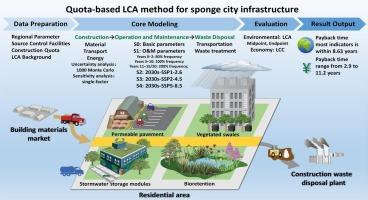桥接LCA与城市建设指标:半干旱中国海绵城市基础设施的新框架
IF 11.2
1区 社会学
Q1 ENVIRONMENTAL STUDIES
引用次数: 0
摘要
海绵城市水源控制设施日益被认为是城市雨水管理的必要条件,但对其环境和经济效益的系统量化仍然有限。本研究开发了一个整合的评估框架,将标准化工程工作量规范与生命周期评估(LCA)联系起来,嵌入施工配额逻辑,以提高可重复性和政策适用性。使用Ecoinvent v3.11数据库和ReCiPe 2016方法,该框架在基线和动态条件下,包括CMIP6气候情景和长期性能退化,评估了中国西北半干旱地区的四种源控制设施类型,包括渗透性路面、雨水储存模块、植被洼地和生物保留。结果表明,每个功能单元的生命周期成本分别为343,400日元、26,100日元、706,600日元和772,300日元。大多数类型的环境投资回收期保持在8.63年以内,而经济投资回收期从2.9年到11.2年不等。建筑材料和运输是主要的环境负担。本研究的贡献有三个方面:它将工程语义嵌入到LCA中进行实际校准,将气候动力学和设施退化纳入情景建模,并联合评估环境和经济回报。总之,这些进展建立了一个可转让的、配额驱动的工具,以支持缺水和数据受限地区的可持续海绵城市发展。本文章由计算机程序翻译,如有差异,请以英文原文为准。

Bridging LCA and urban construction quotas: A novel framework for sponge city infrastructure in semi-arid China
Sponge city source control facilities are increasingly recognized as essential for urban stormwater management, yet systematic quantification of their environmental and economic co-benefits remains limited. This study develops an integrated evaluation framework that links standardized engineering work-quantity norms with life cycle assessment (LCA), embedding construction quota logic to enhance reproducibility and policy applicability. Using the Ecoinvent v3.11 database and the ReCiPe 2016 method, the framework evaluates four source control facility types of permeable pavements, stormwater storage modules, vegetated swales, and bioretention in semi-arid Northwest China under both baseline and dynamic conditions, including CMIP6 climate scenarios and long-term performance degradation. Results indicate that life cycle costs per functional unit are ¥343,400, ¥26,100, ¥706,600, and ¥772,300, respectively. Environmental payback periods remain within 8.63 years for most categories, while economic payback times range from 2.9 to 11.2 years. Construction materials and transportation dominate environmental burdens. The contributions of this study are threefold: it embeds engineering semantics into LCA for practical alignment, integrates climate dynamics and facility degradation into scenario modeling, and jointly evaluates environmental and economic paybacks. Together, these advances establish a transferable, quota-driven tool to support sustainable sponge city development in water-scarce and data-constrained regions.
求助全文
通过发布文献求助,成功后即可免费获取论文全文。
去求助
来源期刊

Environmental Impact Assessment Review
ENVIRONMENTAL STUDIES-
CiteScore
12.60
自引率
10.10%
发文量
200
审稿时长
33 days
期刊介绍:
Environmental Impact Assessment Review is an interdisciplinary journal that serves a global audience of practitioners, policymakers, and academics involved in assessing the environmental impact of policies, projects, processes, and products. The journal focuses on innovative theory and practice in environmental impact assessment (EIA). Papers are expected to present innovative ideas, be topical, and coherent. The journal emphasizes concepts, methods, techniques, approaches, and systems related to EIA theory and practice.
 求助内容:
求助内容: 应助结果提醒方式:
应助结果提醒方式:


